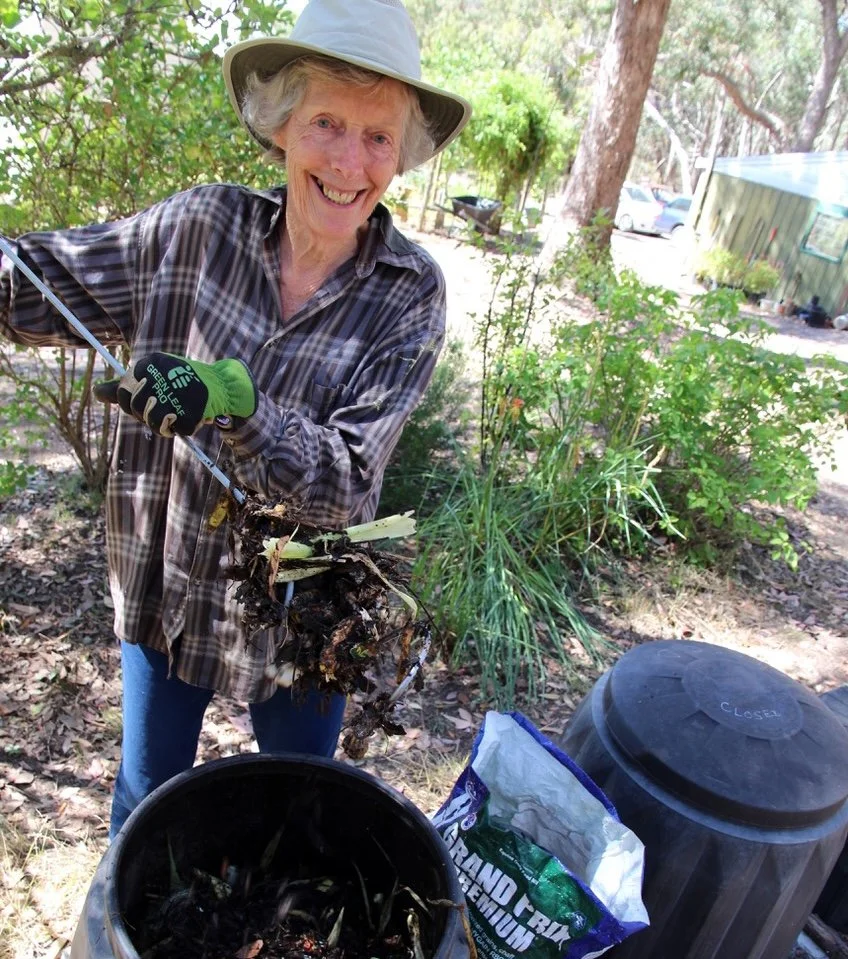Profile of a composter
This week we are taking a stroll around the Taradale garden of long time Mount Alexander Shire Councillor Christine Henderson and having a look under the lid of her compost bins.
Christine and Team Henderson have a rural property on the edge of Taradale nestled into the surrounding bush with productive gardens around the house providing food and bush fire protection for the north facing house.
As I arrived, I was struck by the wonderful passionfruit vine climbing up and across the north veranda of the house and literally dripping with ripe fruit.
The garden lives on tank water, so Christine and Team have moved to wicking beds for most of their productive vegie growing with some wonderful use of trellises to provide vertical and horizontal growing space while offering shaded gardens underneath for less heat loving vegies.
Christine is the head composter and has divided composting into two distinct areas. Close to the garden there’s the larger three bay compost for processing all the garden prunings and woody materials. The garden additions are layered up with animal manures, covered over the top with a thick cloth and are regularly watered to keep the pile moist and the decomposition active. This compost gets added to over the year, with a big influx in autumn. Full bays are left to break down while the next bay is filled.
Out the back of the house is Christine’s food scraps composting area. I love seeing a well organised composting operation, and Christine has everything laid out and ready to go.
Concrete pavers have been laid on leveled ground with two black plastic Gedye-style lidded compost bins sitting on the slab. Christine has rolled fine rodent mesh over the bottom lip of the bin and this, with the pavers, makes a neat rodent-proof system that slows tree roots too. And, don’t worry, Christine tells us “the worms find their way in through the gaps”.
Christine collects enough autumn leaves from the deciduous trees on the property for the whole year, sharing that “it's taken a long while to realise just how much brown (carbon-rich) material needs to go in”. Leaves are on-hand for adding to every bucket of food scraps from the kitchen - that also including torn up cardboard, paper and tissues - with occasional layers of chopped up weeds (no noxious ones) garden soil and manure added for diversity.
A compost screw then gets a good work-out (as does Christine) aerating and blending the top layer with those underneath, “I know things are going well when the mixture is loose and easy to tap out” she says. “If it's a heavy sludge, then it's time for serious additions of leaves and sawdust”, which are all there around the composting area, ready to add.
When the first Gedye bin is close to full and can’t be stirred without losing compost over the sides, the next one is started and the original left to rest for several months. Christine observes “there are usually worms through it by then” making it a perfect “time to transfer the precious material to the waiting garden beds”.
YIMBY composters are often observing the kick they get out of being in the garden and part of those living and dying processes. Christine knows this buzz well, saying “I love it when the steam rises off the top of the mixture on a cool morning. I hold my hand over it and feel the warmth. Compost is magic!”
We think so too!
AUTHOR: JOEL MEADOWS
Joel Meadows works with Yes In My Back Yard, (YIMBY), a community-scale composting initiative in Castlemaine and surrounds. Send questions or comments to hello@yimbycompost.com or to book in for a compost workshop.
This was first published in the Midland Express on the 4 April 2024

